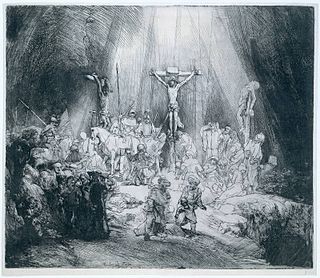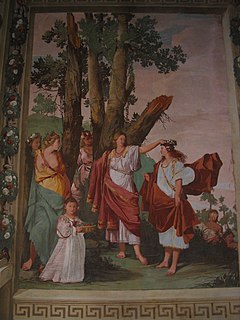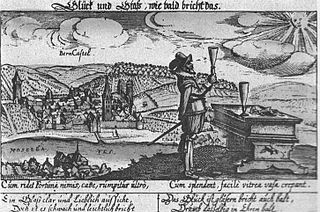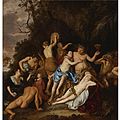
Adriaen van Ostade was a Dutch Golden Age painter of genre works.

Cornelis Cort was a Dutch engraver and draughtsman. He spent the last 12 years of his life in Italy, where he was known as Cornelio Fiammingo.

Wenceslaus Hollar was a prolific and accomplished Bohemian graphic artist of the 17th century, who spent much of his life in England. He is known to German speakers as Wenzel Hollar; and to Czech speakers as Václav HollarCzech: [ˈvaːtslav ˈɦolar]. He is particularly noted for his engravings and etchings. He was born in Prague, died in London, and was buried at St Margaret's Church, Westminster.

Hendrick Danckerts was a Dutch Golden Age landscape painter and engraver.

PhilipGalle was a Dutch publisher, best known for publishing old master prints, which he also produced as designer and engraver. He is especially known for his reproductive engravings of paintings.

An old master print is a work of art produced by a printing process within the Western tradition. The term remains current in the art trade, and there is no easy alternative in English to distinguish the works of "fine art" produced in printmaking from the vast range of decorative, utilitarian and popular prints that grew rapidly alongside the artistic print from the 15th century onwards. Fifteenth-century prints are sufficiently rare that they are classed as old master prints even if they are of crude or merely workmanlike artistic quality. A date of about 1830 is usually taken as marking the end of the period whose prints are covered by this term.

Giulio Carpioni was an Italian painter and etcher of the early Baroque era.
Domenico Maria Bonavera was an Italian engraver. He was born in Bologna. He trained in engraving with his uncle Domenico Maria Canuti. His plates are chiefly etched and finished with the dry point. He engraved eighteen plates from the designs of Titian, for a textbook of anatomy. He completed prints depicting: The Baptism of Christ after Albani; St. Anne teaching the Virgin Mary to read, St. Theresa with the Infant Jesus, and a Martyrdom of St. Christiana after Canuti; a St. John preaching after Ludovico Carracci; Lot and his Daughters after Annibale Carracci; The Assumption fresco at the Cupola of the Duomo of Parma (1697); after Correggio

Fra' Bonaventura Bisi was an Italian painter of the Baroque period. He was also called Il Pittorino or Padre Pittorini, as a Franciscan friar in the convent of S. Francesco in Bologna.

Martino Rota, also Martin Rota and Martin Rota Kolunić was an artist, now mainly known for his printmaking, from Dalmatia.

Jonas Umbach, painter, designer, and engraver, was born at Augsburg about 1624. He was cabinet painter to the Bishop of Augsburg, and produced many landscapes with cattle, also kitchen pieces, feathered game, and a few historical subjects in chiaroscuro. He also etched 230 plates of biblical, historical, and mythological scenes and landscapes. Among these there are:
Bernard Baron was a French engraver and etcher who spent much of his life in England.

Jan de Visscher, was a Dutch Golden Age engraver who became a painter in later life.

Justus Danckerts I was a Dutch engraver and print publisher who along with other members of the Danckerts family created one of the leading Dutch geographical map and atlas publishing houses.
Josias English was an amateur etcher. He was originally thought to have died in 1718, but upon the discovery of his will it transpired his death actually occurred in 1705.

Richard Gaywood was an English engraver.

Sebastian Furck or Fulcarus (c.1589–1666) was a German engraver.
Long View of London from Bankside is a panoramic etching made by Wenceslas Hollar in Antwerp in 1647. It depicts a panorama of London, based on drawings done while Hollar was in London in the early 1640s. Unlike earlier panoramas of London, Hollar's panorama takes a single viewpoint, the tower of St Saviour in Southwark, from where he made the drawings. It shows the River Thames curving sinuously from left to right past the viewpoint.

Giovanni Andrea Podestà or Giovanni Andrea Podesta was an Italian painter and engraver who was principally active in Rome. His principal subject matter is children playing in landscapes with classical objects. His works show the influence of Poussin's Arcadian landscapes and bacchanals, which were ultimately derived from Titian's bacchanals.
Danckert is a Dutch surname. Notable people with the surname include:















